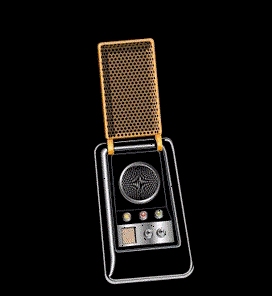
The communicator was a portable transceiver device in use by Starfleet crews to communicate with each other and with the Starship. In the original series of Star Trek, communicators took the form a of a flip lid device and had a standard range of about 20,000 km (with a booster signal provided by the starship). The design was modified at one point to fit around the wrist. By the time of Star Trek: The Next Generation, the communicator functions had been built into the metallic uniform insignia "combadge" worn on the left breast, activated by touch or voice. In addition to providing voice communications, communicators also serve as locator IDs for gaining a transporter lock on personnel. The communicator works by utilising a Subspace Transceiver Assembly (STA), and incorporates an analogue-to-digital voice converter and a low power subspace field emitter. The devices are constructed of a crystalline composition of silicon, beryllium, carbon-70, and gold.

However, the first-ever flip phone design was only released in January 3, 1996 - 30 years after the appearance of the communicator in Star Trek. Manufactured by Motorola, this model was, interestingly, called the StarTac.


The first-ever flip-phone - the StarTac.